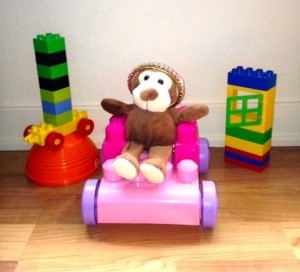A mom I recently met said she doesn’t let her two-year-old play with lego because it involves too much post-play cleaning. I have a toddler myself so I understand her concerns of a messy house.
However, I think there are a couple of reasons why building blocks may just be worth the trouble.
1. Motor skills — Kids use their fingers to pick up pieces of lego and place one on top of the other. This builds their fine motor skills. Sometimes, they need to hold the towers they build steady with one hand when they place the next block on top. This develops coordination and balance.
2. Mental processes — Lego helps kids be creative and use their imagination. Toddlers create bridges, towers and use lego wheels to make cars, while older kids can build spaceships, castles and houses. I’ve noticed that my 2-year-old uses her lego for different things. She makes prints on play dough with different lego shapes. She uses the open side of the pieces as little bowls to fill cheerios and other small objects. She even takes a few in the bath tub to fill and pour water. She places little stuffed animals in her lego car and pushes them around the house.
When kids build, they have to think about process (“First I should put this block on the table, and then place the other on top. Once that is done, I can place yet another block on the second”).
3. Pre-math skills — At the doctor’s office, I noticed a toddler counting all the lego pieces in the toy box. He made two towers, then took note of which tower was taller than the other and tried to make them of equal length.
Kids also learn how to sort and group. Toddlers sort the lego pieces by color, shape and size. Then they build yellow bridges, or houses with only the big red pieces.
4. Laws of Physics — Toddlers learn the basics of structural engineering when they build bridges and skyscrapers. For example, they discover that bridges that are top heavy can be unstable, and that you can only build a tower to a certain height or else it will fall.
Kids also discover friction and acceleration when they play with their lego cars. They find that their cars will roll easily on smooth surfaces and slowly on rough ones, and that they will go fast downhill and will need to be pushed uphill.
5. Interaction with other children and adults — Playing with blocks can be interactive if a child plays with an adult or another child. The child can pick up new ideas on how to build from her playmate. When kids play together, they may experience power struggles. But they will also learn about cooperation and teamwork.
While Lego Duplo is awesome for kids 18 months to age 5, Mega Bloks can cater to children as young as one. Both are great products for budding builders.

